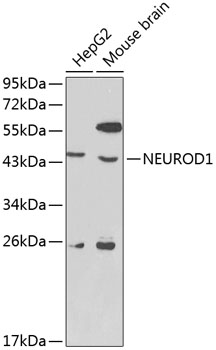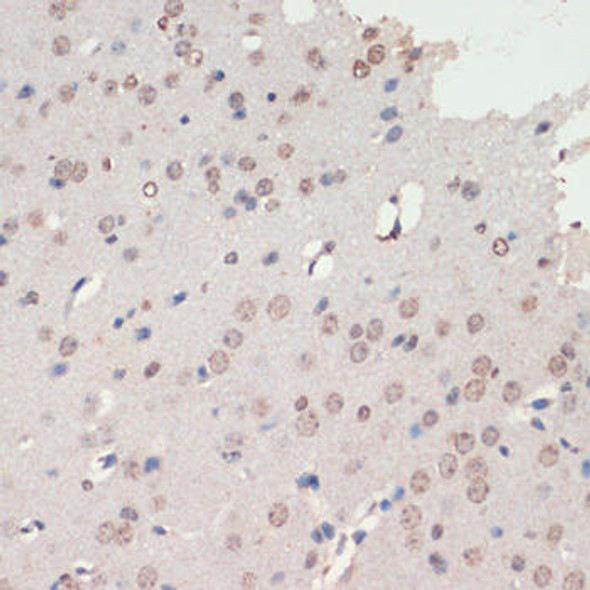Developmental Biology
Anti-NEUROD1 Antibody (CAB1147)
- SKU:
- CAB1147
- Product Type:
- Antibody
- Reactivity:
- Human
- Reactivity:
- Mouse
- Reactivity:
- Rat
- Host Species:
- Rabbit
- Isotype:
- IgG
- Antibody Type:
- Polyclonal Antibody
- Research Area:
- Developmental Biology
Description
| Antibody Name: | Anti-NEUROD1 Antibody |
| Antibody SKU: | CAB1147 |
| Antibody Size: | 20uL, 50uL, 100uL |
| Application: | WB |
| Reactivity: | Human, Mouse, Rat |
| Host Species: | Rabbit |
| Immunogen: | Recombinant fusion protein containing a sequence corresponding to amino acids 1-70 of human NEUROD1 (NP_002491.2). |
| Application: | WB |
| Recommended Dilution: | WB 1:500 - 1:2000 |
| Reactivity: | Human, Mouse, Rat |
| Positive Samples: | HepG2, Mouse brain |
| Immunogen: | Recombinant fusion protein containing a sequence corresponding to amino acids 1-70 of human NEUROD1 (NP_002491.2). |
| Purification Method: | Affinity purification |
| Storage Buffer: | Store at -20'C. Avoid freeze / thaw cycles. Buffer: PBS with 0.02% sodium azide, 50% glycerol, pH7.3. |
| Isotype: | IgG |
| Sequence: | MTKS YSES GLMG EPQP QGPP SWTD ECLS SQDE EHEA DKKE DDLE AMNA EEDS LRNG GEEE DEDE DLEE EE |
| Gene ID: | 4760 |
| Uniprot: | Q13562 |
| Cellular Location: | Cytoplasm, Nucleus |
| Calculated MW: | 39kDa |
| Observed MW: | 40kDa |
| Synonyms: | NEUROD1, BETA2, BHF-1, MODY6, NEUROD, bHLHa3 |
| Background: | This gene encodes a member of the NeuroD family of basic helix-loop-helix (bHLH) transcription factors. The protein forms heterodimers with other bHLH proteins and activates transcription of genes that contain a specific DNA sequence known as the E-box. It regulates expression of the insulin gene, and mutations in this gene result in type II diabetes mellitus. |
| UniProt Protein Function: | NEUROD1: Acts as a transcriptional activator: mediates transcriptional activation by binding to E box-containing promoter consensus core sequences 5'-CANNTG-3'. Associates with the p300/CBP transcription coactivator complex to stimulates transcription of the secretin gene as well as the gene encoding the cyclin-dependent kinase inhibitor p21Cip1. Contributes to the regulation of several cell differentiation pathways, like those that promote the formation of early retinal ganglion cells, inner ear sensory neurons, granule cells forming either the cerebellum or the dentate gyrus cell layer of the hippocampus, endocrine islet cells of the pancreas and enteroendocrine cells of the small intestine. Together with PAX6 or SIX3, is required for the regulation of amacrine cell fate specification. Also required for dendrite morphogenesis and maintenance in the cerebellar cortex. Associates with chromatin to enhancer regulatory elements in genes encoding key transcriptional regulators of neurogenesis. Interacts (via helix-loop-helix motif domain) with EP300 (via C-terminus). Heterodimer with TCF3/E47; the heterodimer is inhibited in presence of ID2, but not NR0B2, to E- box element. Efficient DNA-binding requires dimerization with another bHLH protein. Interacts with RREB1. Interacts with EP300; the interaction is inhibited by NR0B2. Interacts with TCF3; the interaction is inhibited by ID2. |
| UniProt Protein Details: | Protein type:Transcription factor; DNA-binding Chromosomal Location of Human Ortholog: 2q32 Cellular Component: nucleoplasm; cytoplasm; nucleus Molecular Function:protein binding; sequence-specific DNA binding; protein heterodimerization activity; double-stranded DNA binding; transcription coactivator activity; chromatin binding; transcription factor activity; transcription factor binding Biological Process: response to drug; dentate gyrus development; transcription, DNA-dependent; positive regulation of apoptosis; positive regulation of transcription, DNA-dependent; nucleocytoplasmic transport; glucose homeostasis; endocrine pancreas development; anterior/posterior pattern formation; embryonic organ morphogenesis; neurogenesis; insulin secretion; response to glucose stimulus; cerebellum development; positive regulation of transcription from RNA polymerase II promoter; positive regulation of transcription factor activity; positive regulation of neuron differentiation; positive regulation of cell differentiation; regulation of insulin secretion; negative regulation of JAK-STAT cascade; nitric oxide mediated signal transduction; inner ear development Disease: Maturity-onset Diabetes Of The Young, Type 6; Diabetes Mellitus, Noninsulin-dependent |
| NCBI Summary: | This gene encodes a member of the NeuroD family of basic helix-loop-helix (bHLH) transcription factors. The protein forms heterodimers with other bHLH proteins and activates transcription of genes that contain a specific DNA sequence known as the E-box. It regulates expression of the insulin gene, and mutations in this gene result in type II diabetes mellitus. [provided by RefSeq, Jul 2008] |
| UniProt Code: | Q13562 |
| NCBI GenInfo Identifier: | 311033428 |
| NCBI Gene ID: | 4760 |
| NCBI Accession: | Q13562.3 |
| UniProt Related Accession: | Q13562 |
| Molecular Weight: | |
| NCBI Full Name: | Neurogenic differentiation factor 1 |
| NCBI Synonym Full Names: | neuronal differentiation 1 |
| NCBI Official Symbol: | NEUROD1 |
| NCBI Official Synonym Symbols: | BETA2; BHF-1; MODY6; NEUROD; bHLHa3 |
| NCBI Protein Information: | neurogenic differentiation factor 1 |
| UniProt Protein Name: | Neurogenic differentiation factor 1 |
| UniProt Synonym Protein Names: | Class A basic helix-loop-helix protein 3 |
| UniProt Gene Name: | NEUROD1 |
| UniProt Entry Name: | NDF1_HUMAN |







